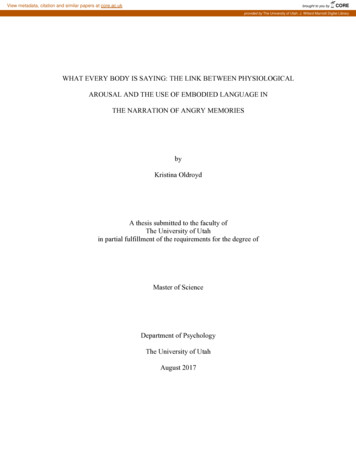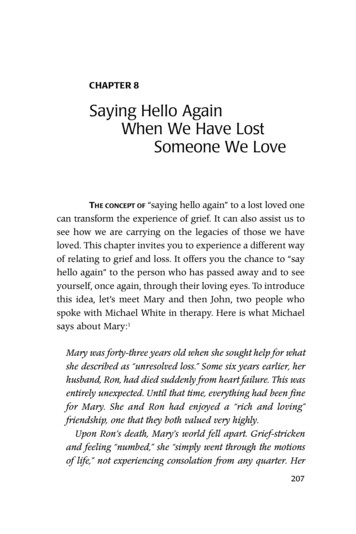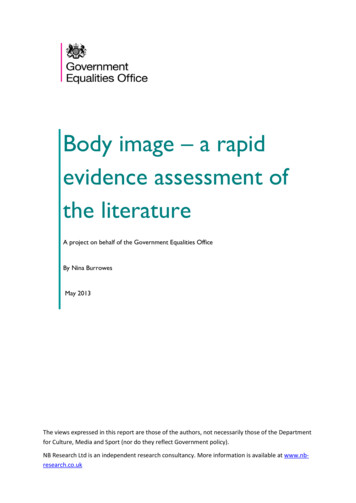
Transcription
View metadata, citation and similar papers at core.ac.ukbrought to you byCOREprovided by The University of Utah: J. Willard Marriott Digital LibraryWHAT EVERY BODY IS SAYING: THE LINK BETWEEN PHYSIOLOGICALAROUSAL AND THE USE OF EMBODIED LANGUAGE INTHE NARRATION OF ANGRY MEMORIESbyKristina OldroydA thesis submitted to the faculty ofThe University of Utahin partial fulfillment of the requirements for the degree ofMaster of ScienceDepartment of PsychologyThe University of UtahAugust 2017
Copyright Kristina Oldroyd 2017All Rights Reserved
The University of Utah Graduate SchoolSTATEMENT OF THESIS APPROVALThe thesis ofKristina Oldroydhas been approved by the following supervisory committee members:Monisha Pasupathi, ChairCecilia Wainryb, MemberJeanine K. Steffanucci, Memberand byLisa Aspinwallthe Department ofand by David B. Kieda, Dean of The Graduate School.4/20/16Date Approved4/20/16Date Approved4/20/16Date Approved, Chair ofPsychology
ABSTRACTIn recent years, the idea that a bidirectional relation exists between physiologicaland psychological processes has become widely accepted. The current data show thatemotions are inextricably linked to the body, and that an inherent part of having anemotional experience is having a physiological reaction. From the perspective of theembodied cognition literature the subsequent recall of an event entails at least a partialreconstruction of the sensory experience that occurred at the time of the originalexperience. Given this, it seems intuitively reasonable that people’s narratives aboutemotional experiences should reflect people’s physical experiences through the use ofembodied language. In this study (n 49) I examined three questions: 1) when, how, andto what extent is the body represented in narratives about everyday emotionalexperiences? 2) Is arousal, both self-reported and physiologically measured, wheninitially recalling an emotional memory associated with aspects of how the body isrepresented in a narrative about that memory? And, 3) does the use of embodiedlanguage in a narrative about an emotional memory change physiological responding tothat memory after narration? In considering these questions I found that while the vastmajority of people use embodied language when narrating about a past emotional event,both the amount and type of embodied language used varied dependent upon gender, selfreported levels of arousal and autonomic nervous system arousal. Specifically, the patternof embodied narration appears to take two distinct pathways. For women a nice adaptive
pattern emerges of higher levels of self-reported anger leading to more embodiedlanguage use, which leads to lower self-reported and sympathetic nervous system arousal.For men, this pattern was not clear, indicating that relation between embodied languageuse and gender is more complex than originally thought.iv
TABLE OF CONTENTSABSTRACT .iiiLIST OF TABLES .viiLIST OF FIGURES . viiiINTRODUCTION . . .1.When, How, and to What Extent Is the Body Represented in Narratives AboutAngry Memories" .3Is Arousal When Initially Recalling an Emotional Memory Associated WithEmbodied Language When Narrating That Memory? Is This RelationshipModerated by Gender? . .10Recalling and Narrating About Emotional Memories . . .12Physiological Responding to Emotion. .14Is the Relation Between Arousal at Initial Recall and the Use of EmbodiedLanguage Moderated by Gender?. . . . .17Does the Use of Embodied Language in a Narrative About an EmotionalMemory Change Self-Reported and Physiological Responding to That MemoryUpon Reexposure?. . . . .18Summary . . . . .21.METHOD . . . .22.Participants.22Measures 23Procedure .26.RESULTS . . . .31.Overall Analytic Strategy . .31Is Arousal When Initially Recalling an Emotional Memory Associated WithEmbodied Language When Narrating That Memory? .33Does the Use of Embodied Language in a Narrative About an Emotional MemoryChange Arousal to That Memory Upon Reexposure? . . 34.DISCUSSION .47.
The Use of Embodied Language in Narrative . .47Limitations and Future Directions . .52.REFERENCES . .55vivi
LIST OF TABLESTables1.PageDescriptive Statistics for Self-Reported Ratings of Anger and PhysiologicalArousal .2.2.Embodied Coding System . 3.Descriptive Statistics of Dependent Variables and Correlations With TimeSince Event . . 4.Correlations and 95% CI’s for Narrative Measures and Self-Reported Anger byEpoch . . 5.Pearson’s Correlations and 95% Confidence Intervals for Narrative Measuresand SCL at Exposure, Standardized for Individuals . .6.Pearson’s Correlations and 95% Confidence Intervals for Narrative Measuresand RSA at Exposure, Standardized for Individuals . .4 .7.Partial Correlations and 95% CI’s for Narrative Measures and SCL at5HHxposure, Controlling for SCL at Exposure . .4 8.Pearson’s Correlations and 95% Confidence Intervals for RSA at Reexposure,Controlling for RSA at Exposure .4
LIST OF FIGURESFigurePage1.Study Design .282.Overall Use of Physical Metaphor .373.Embodied Action Focused Language and Self-Reported Anger.384.Embodied Action Focused Language and SCL .395.Overall Physical Metaphor Use and RSA Arousal .406.Patterns of Arousal and the Use of Embodied Language . . .54.
INTRODUCTIONPeople talk about the distressing events in their lives. They share their sadmoments, their disappointments, the frustrating and the infuriating in an effort to makesense of them, to find meaning in them, and to grow from them. In spite of all that wehave learned about narrative construction over the past 2 decades, specifically about thesocial, emotional, and cognitive processes surrounding it, to date, the study of storytellingremains notably disembodied. That is, considering that every experience about which wewould construct a narrative happens to our physical bodies, and that an inherent part ofhaving an emotional experience is having a physiological reaction, to our knowledge,little to no systematic work has been done to investigate how people represent theirbodies in autobiographical narratives, and what the implications for doing so may be.Both literal and metaphorical representations of the body are omnipresent inliterature, across a wide range of writing, from children’s fiction to adult autobiography.Consider this passage from the popular children’s book When Sophie Gets Angry, Really,Really Angry: “When Sophie gets angry, really, really angry She kicks. She screams.She wants to smash the world to smithereens. She roars a red, red roar, and Sophie is avolcano, ready to explode” (Bang, 2004, p. 16).Or this passage from the notable neo-Freudian psychoanalyst Karen Horney(1966) written to convey her feelings of anger and confusion, in her book New Ways inPsychoanalysis:
2Everything in me is storming and surging and pressing for light that will resolve theconfusion. I seem to myself like a skipper who leaps from his safe ship into the sea, whoclings to a timber and lets himself be driven by the sea’s tumult, now, here, now there. Hedoesn’t know where he is going. (p. 232)As demonstrated by the examples above, both young children and adults rely onembodied language and physical metaphor to both understand and communicate theiremotional experience. In the children’s book, the author links Sophie’s internal emotionalexperience to Sophie’s externalized behavior in a very simple way, using the physicalmetaphor of a volcano to describe the internal experience of anger. On a much moresophisticated level, Horney uses the same techniques to represent her feelings of anger.Such linguistic representations of embodied experience, defined throughout this paper aslanguage that conveys subjective and psychological experience using words and phrasesthat are based on physical, tangible action and experience, are omnipresent in fiction andliterature and help to make the details of the story vivid for the reader. Throughout theremainder of this article, I will refer to these features of narratives with the term“embodied language.”In spite of the prevalence of embodied language in autobiography and literature,from a scientific point of view, we still have really basic questions to answer about when,where, and how embodied language is used in everyday narratives. While the embodiedcognition literature is investigating the link between physical experience, cognition, andbehavior in a number of other domains, including language processing, to our knowledge,there have been few investigations about the relation between physiological experienceand narration, and none concerning the use of embodied language in autobiographicalnarratives. Thus, in this study, designed to be a preliminary investigation into this topic, Iask three basic questions: 1) When, how, and to what extent is the body represented in
3narratives about everyday angry experiences? 2) Is arousal, either self-reported orphysiologically measured, when remembering an emotional memory associated with theuse of embodied language during narration of that memory? And, 3) Does the use ofembodied language in narrating that memory change physiological responding at reexposure to that memory?When, How, and to What Extent ,s the Body Represented inNarratives About Angry Memories?Narratives are defined as goal structured accounts of past events (Bruner, 1991)that range from brief anecdotes (Bamberg, 2006) to fully developed autobiographies(McAdams, 2001, 2008; Singer & Bluck, 2001). As individuals construct narrativesabout the events in their lives they interpret and evaluate the storied events, assignintention to the actors, delineate the physical and psychological consequences tothemselves and others, and make meaning of what happened. In so doing, the narrativesthat people construct become much more than factual descriptions of events; they havethe potential to become the building blocks for identity development (McAdams &McLean, 2013; McLean et al., 2010; Pasupathi & Hoyt, 2009), perspective taking (Dunnet al., 1987; Fivush, 1991), meaning-making (Conway & Singer, 2004; McLean, 2005),and emotion regulation (Pasupathi, 2003; Pasupathi et al., in press; Thompson et al.,1993).While the extant literature does a good job of detailing the varied ways peopleconstruct narratives and the effects such narratives have on psychological outcomes (e.g.,increased well-being, the ability to make meaning of an experience, to bring about asense of resolution, etc.) researchers have had little to say regarding how a person’s
4physical experience at exposure to a memory may impact the features of the narrativeabout that memory. In other words, the majority of the narrative work to-date focuses onthe narrator’s psychological experience rather than their physical experience. Forexample, when narrative researchers talk about a story being “resolved,” they mean thatthe event is resolved psychologically for the narrator, not necessarily resolved in thephysical, tangible world.It is important to note that in saying that the embodied aspect of narrative hasnot been studied I do not mean to imply that embodiment does not manifest in theliterature. To the contrary, examples of embodied language in narratives are easy to findboth within and outside of the psychological literature, as I consider in the next section.However, embodied language has yet to be examined as a unique and potentiallyimportant aspect of autobiographical narratives. In what follows, I consider the way thatpeople’s physical experience may be represented in narratives based on an examinationof narratives from a broad sample of readings.Embodied Action LanguagePerhaps the most common way that the body appears in narrative is throughdescriptions of the body’s capabilities and actions, what I will call throughout the rest ofthis article, embodied action. While seeming like a necessarily inherent piece of anarrative, essential in order to tell a story, the implications of how the body’s actions arerepresented in a narrative may be as psychologically relevant as they are practical. Forexample, consider the following narrative from Olivia: “I run. I know that my body isstrong and I know that I put a lot of work into keeping it healthy. And so, I'm definitely alot more confident and proud, I guess, now” (Busanich, 2012, p. 312). To Olivia, what
5she does with her body (run) helps to shape her identity and impacts how she feels aboutherself (confident and proud).Ballerina Gelsey Kirkland demonstrates the same phenomenon in her book,Dancing on My Grave, when she writes about what it is like for a dancer to recover froma debilitating injury. “You can come back and feel quite uncoordinated, like a stranger inyour own body if you haven’t danced for a while” (Kirkland, 1980, p. 312). Again, whatthe body can do, or in this case can’t do, shapes the narrator’s identity and impacts howshe feels about herself.A slightly more subtle way of portraying embodied action in narrative is throughthe conveyance of specific, sensory details. Sensory details include sight, sound, touch,smell, and taste imply action on the part of the body and serve to envelope both the writerand the listener in the narrator’s experience. In this passage, Louie Zamarini describeswhat he experienced after his aircraft was shot down in the Pacific during World War II:I found the raft offered an unlikely intellectual refuge. I had never recognized hownoisy the civilized world was. Here, drifting in almost total silence, with no scentsother than the singed odor of the raft, no flavors on my tongue, nothing movingbut the slow procession of shark fins, every vista empty save water and sky, mytime unvaried and unbroken, my mind was freed of an encumbrance thatcivilization had imposed on it. In my head, I could roam anywhere, and I foundthat my mind was quick and clear, my imagination unfettered and supple. I couldstay with a thought for hours, turning it about. (Hillenbrand, 2010, p. 113)Another way that embodied language appears in people’s narratives is as amessenger or purveyor of emotion. Emotions consist of three critical components:physiological arousal (autonomic responses), subjective emotional experience, andexpressive behavior (e.g., facial expressions) (Fridja, 1993). Current emotion theoriespurport that knowledge about one’s emotional state comes in part from the awareness andinterpretation of physiological arousal (Damasio, 2000; Kever et al., 2015; Niedenthal &
6Maringer, 2009). From this perspective, it is in experiencing my heart begin to race, mymouth becoming dry, my skin turning pale and my gut contracting, that would allow meto ascertain that, “I am afraid.” In other words, in some cases, the experience of emotionis bottom-up and it is our physical experiences that serve to inform our psychologicalstates. Consider this description of anger written by a 14-year-old female: "I get thisbubble of rage. I go wild. I feel like crying cause I don’t know how to control myself. Ithappens too quickly. I am angry" (Personal letter).In this narrative, it is the girl’s physical experience that both prompts herrealization of and drives her psychological experience of anger. Therefore, for this storyto make any sense to a listener, and in order for it to be able to adequately convey thenarrator’s invisible psychological experience, it must be grounded within a realm sharedby both the speaker and the listener: the world of physical experiences.In other narratives, the body is used to communicate information not to thenarrator, but to others. This is exemplified in the following narrative written by Sandra, ayoung woman suffering from anorexia nervosa: “It (my weight) was my body’s way totell others that I had a problem, a mental problem. That you don’t feel good aboutyourself” (Nordbø et al., 2006, p. 13)Both of these narratives illustrate the central role the body plays in thecommunication of emotion to the self and to others. Thus, given the importance oflinguistic representations of embodied experience to the process of accurately and vividlyportraying emotional experiences, I will examine the presence of physical descriptions offelt emotion as an important communicator of embodied state.Each of the aforementioned narratives illustrates that without the inclusion of
7embodied action language narratives would seem incoherent and incomplete (Linde,1993; Reese et al., 2011). Coherence then demonstrates one way in which embodiedlanguage is already implicitly captured in research on narrative (Linde, 1993; Reese et al.,2011). This is important as coherence is both socially demanded (Linde, 1993) and linkedto well-being (Baerger, 1999; Waters & Fivush, 2015). The use of embodied action in anarrative also contributes to its overall elaborateness, another feature that has also beenrelated to meaningful psychological outcomes (Adler et al., 2015; Pals, 2006;Pennebaker, 2009).Though inclusions of embodied action are fundamental to a complete narrative, itis clear that people vary in the extent to which they focus on the embodied aspects versusthe psychological aspects of experience more emphasized by traditional narrativeapproaches (Pasupathi et al., 2014). Consider the following narrative expressing thewriter’s grief:When I was 17, my dog was ill I had to be the one to take her to put her to sleep.At first I stayed strong, but after we arrived at the vet my heart sank and the tearsstarted to flow. At this point I couldn’t hold back the sobs and struggled for thenext while to keep my composure. (narrative collected in our lab)The preceding story is filled with embodied language as the narrator strives tocommunicate his cognitive, physical, and emotional experience to the reader. Contrastthis with another narrative collected about grief: “My friend killed himself and it mademe feel really sad. I also felt a little guilty. As any friend would because we all think wecould have prevented it. It was the worst time of my life. Every time I think about itmakes me sad” (Data collected in lab).While the emotional experience of grief is the same in both narratives, the level ofembodied language use is significantly different. Specifically, in the second narrative,
8there is no evidence of embodied language use on the part of the narrator, and this mayhave important implications for psychological processes down the road.In all of the aforementioned narratives (those about running, dancing, feeling,etc.), it is the writers’ descriptions of their embodied action that lay the foundation for themore psychologically oriented work typically studied in the narrative literature (e.g.,exploration, meaning making, identity formation, growth, etc.). In other words, it is onlyafter the preliminary descriptions of the body and its’ physical states are described doesthe narrator delve into the deeper, psychologically oriented work of narrative. Given thisI believe that descriptions of embodied action may play an important role in building afoundation for a coherent, meaning-laden, growth-inducing narrative.Physical MetaphorPhysical metaphor is another way that people may linguistically representembodied experience. Conceptual metaphor theory (CMT) describes the way thatindividuals make sense of abstract concepts, including emotions, by grounding them inpatterns of bodily actions and manipulations of tangible objects (Gibbs et al., 2006;Lakoff & Johnson, 2008). From this perspective, people use physical metaphor to bothdescribe and to understand difficult-to-explain emotions or experiences. Consider thepopular colloquialism, heart broken. This is the word that Ron used to describe himselfafter the death of his daughter Mary:I am heartbroken. There is always this sort of an underlying gnawing sensation,you know. You feel it in your heart, I think. And that maybe there is a heavinessof heart. I sigh that, I don’t know, is very sad that the death happened. I think thatI will always carry it with me It is like a physical presence of a weight bearingon in my body (Gudmundsdottir, 2009, p. 6)
9The physical metaphors used in this paragraph (e.g., heart being broken, a gnawingsensation, carrying a burden, the presence of a weight) combine to describe the elusive,inexplicable experience of losing a child into a cohesive, contained scenario that mostreaders, though having not lost a child themselves, can relate to. Importantly, it is theclaim of conceptual metaphor theory (CMT) that the ability of the reader to make senseof these metaphors resides in the readers’ automatic construction of a mental simulationwhereby we imagine performing the bodily actions referred to in the excerpt. Thus,metaphorical references to “carrying a burden” are understood by the reader’s mentallysimulating what it must be like to carry a heavy weight (Gibbs Jr., 2013; Lakoff &Johnson, 2008).This same linguistic strategy of grounding an elusive, hard to explainpsychological concept in everyday physical reality, is used in the following excerpt by aboxer as he tries to communicate his passion for his sport:The boxer willfully perseveres in this potentially self-destructive trade because, ina very real sense, he is inhabited by the game that he inhabits . . . a veteranmiddleweight who has rumbled on three continents for over a decade . . .[commented], ‘you can’t (give it up) it’s in your blood so much . . . you can’t giveit up’. (Wacquant, 2005, p. 88)The physical metaphors used in this paragraph (e.g., boxing being in your blood;inhabiting the sport of boxing) describe the experience of being passionate about a sportin a way that most readers, even if not enthralled with boxing themselves, can understand(Gibbs Jr., 2013; Lakoff & Johnson, 2008).In sum, embodied action language and physical metaphor are widely evident innarratives about personal experience in both research and popular press contexts, and arelikely related to elaboration and coherence – concepts narrative researchers have studied
10previously. However, embodied language has not been quantified and examined in itsown right. The first goal of the present study then was to develop a reliable way ofquantifying embodied action language and physical metaphor, and to examine theprevalence of such language in narratives about everyday emotional experience.Assuming that people will use embodied language and that the prevalence ofembodied language use will vary across people, as do other more widely studied narrativevariables (e.g., meaning making, coherence, elaboration), our second question addresses apotential reason for that variance, one that is tied directly to the body and its physicalexperience. Specifically, I ask the question, is arousal when initially recalling anemotional memory associated with embodied language when narrating that memory?Is Arousal When Initially Recalling an Emotional Memory Associated WithEmbodied Language When Narrating That Memory? Is ThisRelationship Moderated by Gender?Self-Report Ratings of ArousalFrom the discrete emotions perspective, emotions consist of both subjectiveratings and objective physiological components (e.g., Frijda & Levenson, 1988). Giventhis, we measured both of these parts of the emotional experience and included them inthis study: the subjective components via self-report ratings of anger, with higher angerindicating higher subjective arousal, during each epoch, and the physiologicalcomponents via measures of autonomic nervous system arousal (respiratory sinusarrhythmia (RSA) and skin conductance levels (SCL). I examined each uniquecomponent and their associations with the use of embodied language separately.Given that the self-report ratings of arousal and the physiological ratings ofarousal do not always move together, I believe that including both reports of arousal is
11important in the context of this study because people’s interpretations of physiologicalarousal have been shown to vary (Levenson, Carstensen, & Gross, 1994). In other words,while an increase in heart rate may be highly distressing to one individual, necessitatingthe use of a myriad of coping skills, another individual may be relatively undisturbed, oreven unaware, of the same increase in heart rate. By looking at the relation between bothcomponents of a discrete emotion and its relation with the use of embodied language, Ibelieve that I will gain a broader perspective on representations of the body in narrative.Physiological Measures of ArousalThe relation between autonomic nervous system (ANS) arousal and emotion hasbeen widely studied (see Levinson, 2014 for a review). A key premise of functionalisttheories of emotion is that emotions organize the activity of the ANS and otherphysiological systems and have noticeable effects on bodily states (e.g., Bradley et al.,2001; Levenson, 1992). From this point of view, emotional experiences are partiallyencoded in our physiological responses to an experience and simply thinking about anevent invokes the partial reproduction of the autonomic arousal states that occurredduring the actual event (Barsalou, 1999; Barsalou et al., 2008). Some importantimplications of this for the present study are that (1) emotions are embodied in the formof measureable physiological arousal; and (2) far from being incidental, arousal affectsand shapes information processing, which could be reflected in narratives (Winkielman etal., 2015). In this study, I am asking whether or not the physiological states that occurwhen initially recalling an emotional event are related to representations of embodiedexperience in participants’ narratives about that emotional experience.
12Recalling and Narrating About Emotional MemoriesPhysiological Arousal and Language ProcessingA robust body of past work has demonstrated that physical experience andphysiological arousal play a causal role in the conceptual and emotional understanding oflanguage (Niedenthal et al., 2005; Niedenthal & Maringer, 2009; Winkielman et al.,2015). Indeed the evidence supports a relationship between physical states and multiplelinguistic processes such as lexical access (Borghi et al., 2004), syntactic analysis(Chambers et al., 2004) and sentence comprehension (Glenberg & Kaschak, 2002). Forexample, a smiling participant is quicker to identify a smiling face and pull a levertowards them (an approach movement) than a frowning participant (e.g., Frijda, 1986;Lang, 1995), and the facial muscles used in smiling (zygomaticus major and orbicularisoculi) are more active during the reading of happy sentences than sad sentences(Glenberg, 2009). These data suggest that embodied action and physiological arousal gohand in hand with the processing and understanding of emotion and language. Byextension, I believe that embodied action and physiological arousal could also relate tolanguage production in narrating emotional experience.Sato, Schafer, and Bergen (2007) took an initial step toward demonstrating theeffect of embodied action on the use of language. In their study, they relied on thecommon conceptual metaphors of happiness being a thing to search for (e.g., he was onthe path to happiness) and joy being a container (e.g., his joy was overflowing).Experimenters approached individuals in public places (i.e., a grocery store, the library,restaurants) who were either searching for something or drinking something. Onceidentified, participants were asked to describe a person in an emotionally ambiguous
13picture as either “searching for happiness” or being “filled with joy.” A main effect ofparticipants’ embodied action immediately prior to their choice showed that participantswho were engaged in searching behavior used the happiness metaphor 54% more oftenthan the joy metaphor (p .001, two-tailed Fisher’s exact test). This study supports theidea that there will be a relationship between physiology and narration such that higherphysiological arousal might correspond to subsequently using more embodied languageto narrate an event.Other work linking narrative and physiology has been conducted within the fieldof expressive writing. This literature demonstrates that when individuals talk or writeabout emotional events, important biological changes occur (Pennebaker, 1989). Forexample, multiple studies indicate that talking about trauma in the laboratory results inchanges in participants’ blood pressure, heart rate variability, muscle tension, and skinconductance both during and immediately after disclosure; specifically, people showdecreased levels of arousal across all of these measures. People manifest lower bloodpressure (McGuire, 2005), lower respiration and heart rates (Pennebaker, Hughes, &O’Heeeron, 1987) and lower levels of skin conductance after writing (Francis &Pennebaker, 2002). These results have been duplicated across the spectrum
WHAT EVERY BODY IS SAYING: THE LINK BETWEEN PHYSIOLOGICAL AROUSAL AND THE USE OF EMBODIED LANGUAGE IN THE NARRATION OF ANGRY MEMORIES by Kristina Oldroyd A thesis submitted to the faculty of The University of Utah in partial fulfillment of the requirements for the degree of Maste










